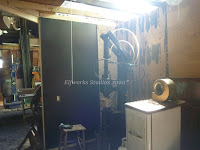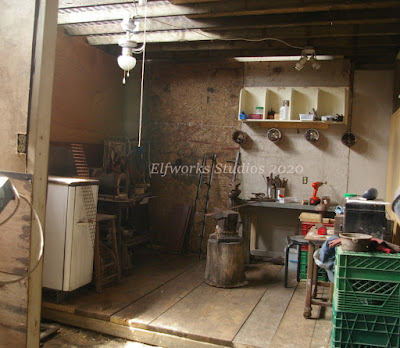Okay, I wrote this post months ago, and took the photos - it was one of those 5am writing things. And then I have let it sit, unpublished for far too long.
The world is an upside down place these days and I'm struggling to make myself do the things I want to do. I love making for Elfworks, but I'm lousy at the marketing and promo stuff. Lately I've even been lousy at the making. But I'm still here, and here is some kind of update on what's been happening over the past months....
Yes, here it is months
later and I've written nothing more about my Very Exciting Shop
Renovation. I confess, I've had my hands firmly in the dirt trying
to grow things, and lay groundwork for other projects for almost all
the intervening time. In my defense, this is all part of the larger
Elfworks picture, but has not gotten me far in the shop.
I mentioned that my partner
Darrell had done all the actual building of the space. While it is
hard for me to let go, it was a wise decision. He is a much better
builder than I am, and has a lot more experience. The result being
that my shop is very awesome. Not fancy, not shiny, but awesome.
Much of the wood that was used was recycled from other projects, so
it is a patchwork in many ways, but that had its advantages too
(besides lowering the cost.)
Darrell started by framing
in the walls, then the floor. The floorboards were laid, but not
attached while he worked on walls and insulation and wiring (yes,
that's right, insulation!!) The ceiling was framed in – we are
dropping the ceiling to make it easier to heat...not like I need head
room! The window on the northwest wall was framed in – positioned
to allow light in from the window in the outside wall of the
building. And then it got even more exciting.
 Once the walls were up, the
floor got finished – Darrell put a little bit of insulation under
the floor and the boards got screwed down. The larger pieces had
been loosely placed on the boards for layout and positioning and got
moved back into their homes. I made measurements and did chalkmark
layout of the rest of the space.
Once the walls were up, the
floor got finished – Darrell put a little bit of insulation under
the floor and the boards got screwed down. The larger pieces had
been loosely placed on the boards for layout and positioning and got
moved back into their homes. I made measurements and did chalkmark
layout of the rest of the space.
We had talked about
bench space, something I've never had much of with the result of
always having to shift tools and projects, well, off of other tools
and projects frankly. Never having had it, I wasn't sure how much of
it I would need. I listened to the voice of experience, and opted
for more rather than less. There was a scrounged steel counter that
was laying around, but when I looked at it it seemed extremely
imposing and space consuming. I mentioned that I am small, looking
at the counter what I saw was wasted space where I would inevitably
pile things and continue my bad habits.

Solution? Rip it in half
and make 2 narrow sections rather than 2 large sections. I love that
we are metal people. Deciding on its height was also a big
challenge. I am so used to having everything the wrong size that
this was a big learning curve. Once the height was settled, sturdy
framing set it firmly in place, and a leg vise, appropriately
adjusted for height, was attached. (The attachment bracket of the
leg vise was a partial decider on the height.)
I went outside one day and
found Darrell atop a ladder, pulling boards from the outside of the
building. One of the things we had talked about was light –
natural light. While it is true that natural light can be difficult
in a smith's shop – the colours always changing depending on how
the light falls, I knew I needed it. I find it too hard to work in a
dark space and light where there are no windows is always somehow,
inadequate (for me.)
Solution? The original solution was that
window I talked about on the north wall. On further discussion,
Darrell suggested we could put windows on the top of the south wall
of the building and put a clear panel into my ceiling to allow for
more light.
Again, there were a number
of scrounged windows waiting for use, so they got put into play.
While it was a big job, I cannot tell you the difference it has made,
not just in my shop but in the shop as a whole.
Suddenly the world
is lit up with those 2 windows in that wall. And my shop in
particular practically gleams when you enter. Although we did
install a ceiling fan overhead light, as well as making provisions
for other lights where needed, during the day they have become almost
redundant. Suddenly the shop that was already so exciting became a
real joy. Working there will be an easy task, and I know that I can
adjust to changing light, though there will be some tasks that will
be more challenging with it.
The boards for the walls
were chosen and placed with thought to texture (or lack thereof.)
This meant that I could turn one full panel and one of the panels
above my fantastic new benches into chalkboard. They are already
covered in lists of “to do” - largely custom hooks to give my
stakes permanent storage places under my benches...off the floor.
The wheeled metal frame
that used to hold my propane forge was customized and given new life
as a stand for my swage block and bench plate. The casters allow me
to leave it stored against the wall or move it into closer proximity
to the forge on my lovely wooden floor.
The propane forge now sits
on a plate covering the firebox of the coal forge – allowing for me
to switch to coal on larger or more curved objects (though the
ventilation is not in yet.) The coal forge – a portable table
style sits atop a metal plate, which gives me extra space for cooling
pieces, still on the floor as is my longtime habit, but well out of
the way of my feet.
The forge itself is
positioned so that I can either use my anvil, my leg vise or step
down and use my BAAT Hammer with ease. It will take a bit of getting
used to that it isn't in the corner, but the placement is much
better, especially with the changes in equipment.

An old freestanding wire
basket style shelf has been repurposed as my hammer rack, also
holding many spare sets of tongs and a few other pieces, nestled in
the corner where my forge used to be. And steel is now stored in a
rack on the west wall, neatly sorted (well, mostly) rather than a
mass of buckets with random odds everywhere. Longer pieces are
stored just outside the new shop space against a wall. Everything is
safely chained off – and I can actually see what stock I have. Not
surprisingly I have more than I realized. And now I'll be able to
find it rather than assuming I don't have any and buying more. It
will also serve as a reminder of the projects I'm supposed to be
doing...things I bought stock for, stored it and then forgot about
it, project and all.
There are still things to
be done – a stack for the woodstove has to be installed,
ventilation for the coal forge put in, doors to the space to be built
an attached, but the place is a joy to work in. I haven't gotten
very far just yet. There is a lot of new to get used to, everything
has new homes – shelves and racks and a level of organization that
will take some fine tuning and a lot more familiarity before it
achieves the efficiency it promises. And I have been mostly trying
to “make hay while the sun shines” and all that...true enough.
But I can tell you that
I've had inspiration for 3 new large projects since this adventure
began – larger than any of the things I've attempted yet. This is
a space where I can see things happening, and keep track of what I'm
doing. Not that the previous spaces were to blame for that lack –
that was all on me. This space though, and the time ahead where I am
here and not travelling to and fro to that other life that is on hold
for the forseeable future...well, I have much hope for the
undertaking of great adventures.




























